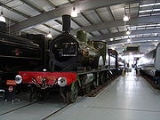
LSWR T3 class
Encyclopedia
The LSWR T3 class was a class of express passenger 4-4-0
steam locomotive
s designed for the London and South Western Railway
by William Adams
. Twenty were constructed between 1892–1893.
The class were numbered 557–576, and had been intended as a variant of the X2 class
with slightly smaller driving wheels (6 in 7 in (2.01 m) versus 7 in 1 in (2.16 m)). In reality, the coupled wheelbase was lengthened by 6 inches (15.2 cm) and the locomotive was fitted with a firebox 6 in 10 in (2.08 m) deep – the largest firebox of any of Adams' designs.
All passed to the Southern Railway
at the grouping
in 1923. Withdrawals started in 1930, and by the end of 1933 only three remained. No. 557 went in 1936, 571 in 1943, and the last, 563 was retired in August 1945 and set aside for preservation. Its permanent home is the Shildon Locomotion Museum
in England, but it's in Toronto
, Ontario
, from May to October, 2011, on loan for use in a theatrical production of The Railway Children
at Roundhouse Park.
4-4-0
Under the Whyte notation for the classification of steam locomotives, 4-4-0 represents the wheel arrangement of four leading wheels on two axles , four powered and coupled driving wheels on two axles, and no trailing wheels...
steam locomotive
Steam locomotive
A steam locomotive is a railway locomotive that produces its power through a steam engine. These locomotives are fueled by burning some combustible material, usually coal, wood or oil, to produce steam in a boiler, which drives the steam engine...
s designed for the London and South Western Railway
London and South Western Railway
The London and South Western Railway was a railway company in England from 1838 to 1922. Its network extended from London to Plymouth via Salisbury and Exeter, with branches to Ilfracombe and Padstow and via Southampton to Bournemouth and Weymouth. It also had many routes connecting towns in...
by William Adams
William Adams (locomotive engineer)
William Adams was the Locomotive Superintendent of the North London Railway from 1858 to 1873; the Great Eastern Railway from 1873 until 1878 and the London and South Western Railway from then until his retirement in 1895...
. Twenty were constructed between 1892–1893.
The class were numbered 557–576, and had been intended as a variant of the X2 class
LSWR X2 class
The LSWR X2 class was a class of express passenger 4-4-0 steam locomotives designed for the London and South Western Railway by William Adams. Twenty were constructed at Nine Elms Locomotive Works between 1880–1882....
with slightly smaller driving wheels (6 in 7 in (2.01 m) versus 7 in 1 in (2.16 m)). In reality, the coupled wheelbase was lengthened by 6 inches (15.2 cm) and the locomotive was fitted with a firebox 6 in 10 in (2.08 m) deep – the largest firebox of any of Adams' designs.
| Year | Order | Quantity | LSWR Numbers | Notes |
|---|---|---|---|---|
| 1892 | T3 | 10 | 557–566 | |
| 1893 | S5 | 10 | 567–576 | |
All passed to the Southern Railway
Southern Railway (Great Britain)
The Southern Railway was a British railway company established in the 1923 Grouping. It linked London with the Channel ports, South West England, South coast resorts and Kent...
at the grouping
Railways Act 1921
The Railways Act 1921, also known as the Grouping Act, was an enactment by the British government of David Lloyd George intended to stem the losses being made by many of the country's 120 railway companies, move the railways away from internal competition, and to retain some of the benefits which...
in 1923. Withdrawals started in 1930, and by the end of 1933 only three remained. No. 557 went in 1936, 571 in 1943, and the last, 563 was retired in August 1945 and set aside for preservation. Its permanent home is the Shildon Locomotion Museum
Shildon Locomotion Museum
Shildon Locomotion Museum is a railway museum in Shildon, County Durham, England. The museum is a branch of the National Railway Museum , which is part of the National Museum of Science and Industry...
in England, but it's in Toronto
Toronto
Toronto is the provincial capital of Ontario and the largest city in Canada. It is located in Southern Ontario on the northwestern shore of Lake Ontario. A relatively modern city, Toronto's history dates back to the late-18th century, when its land was first purchased by the British monarchy from...
, Ontario
Ontario
Ontario is a province of Canada, located in east-central Canada. It is Canada's most populous province and second largest in total area. It is home to the nation's most populous city, Toronto, and the nation's capital, Ottawa....
, from May to October, 2011, on loan for use in a theatrical production of The Railway Children
The Railway Children
The Railway Children is a children's book by Edith Nesbit, originally serialised in The London Magazine during 1905 and first published in book form in 1906...
at Roundhouse Park.

